survey results: only 2% of LJ-ists download music legally
The results of the poll " Where do people take music and video "
HIGHLIGHTS
=== Of every 10 LJ-ists, one shook a lot, six - only for free, three sometimes paid.
')
=== Only 2% of respondents legally downloaded music ...
PRO POLL
The survey began on April 7, 2007. In three weeks, 262 Russian-speaking LJ users took part in it.
57% of them live in Russia, 27% in the USA, 16% in the rest of the world.
I selected the American survey participants from the San Francisco Bay Area into a separate group because of the higher concentration of computer-literate people in these parts. Residents of the Bay Area accounted for 14% of the total number of respondents, the rest of America - 13%.
About download terminology:
- free of charge - this is from a donkey, news groups, a torrent, a district network, as a souvenir on a self-made disc from a friend, copied from a library, etc., where you are not charged anything for accessing these files;
- not for free - this is for money, but smaller than they usually want in official US stores like iTunes, that is, for example, on allofmp3.com, delit.net, mp3spy.ru, getmusic.ru, yanga.ru, etc. p. - everything that may be legal in Russia, but definitely angers right holders in America;
- legally - this is when a song is for 99 or more cents, an episode of a TV show for two green rubles, and a movie for 10 ... 15, OR music and movies from hire or library (not in copies), OR recorded on DVR, when you pay for this service to the cable provider, OR purchased at a regular store, OR at ibey, but in a real box / package, etc.
MUSIC
The survey once again confirmed that the world is changing.
Vinyl records have been replaced by CDs once. Now they are being supplanted by mp3 files, which often get from the Internet to computers and then to players, bypassing physical media. When asked what music is played most of the time, 57% of respondents said that they listen to music on a computer; 29% - in mp3-players (while 20% - in flash players, the rest - in players with built-in hard drive). Thus, for 87% of the audio files have already become what a couple of decades ago for the majority were vinyl records and compact tapes.
 Chart 1
Chart 1
(all charts can be opened in a separate window - they will be easier to read)
* * * *
Those who spend a lot of time at the computer, spend money on the world in which they live - it happens that they pay for downloading music. Those who are at the computer no more than two hours a day, much more often get the music offline, and do not pay for downloading.
 Chart 2
Chart 2
* * * *
Free downloading of music among Russian-speaking users of LiveJournal is massive - 92% of respondents know how and find where to download, not paying attention to legality.
58% of respondents shook only for free, 34% - sometimes paid. Only 2% of respondents rocked only legally. 6% did not download at all.
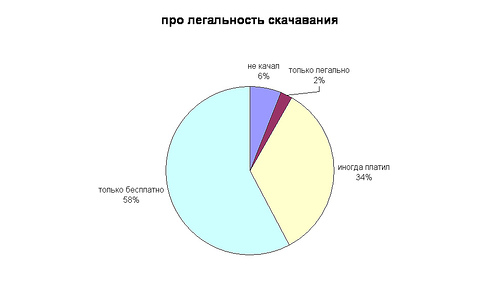 Chart 3
Chart 3
On closer inspection, 92% of those who swing for free look, however, less impressively: most of them are pumping quite a bit. Up to 3 albums appeared in 53% of respondents per month (by all means, download, copy, buy in offline stores, etc.).
 Chart 4
Chart 4
Only 9% shakes a lot of music for free. “Many” - these are many dozens of new albums that have appeared over the past three months.
 Chart 5
Chart 5
VIDEO
The video shakes a little less than the people than the music:
 Chart 6
Chart 6
The following graph shows that the main sources of video for Americans are the purchase of licensed DVDs, cable television and online rental. And the Russians have no online DVD rental, but a high percentage of pirated discs. Thus - even with the opportunity to download for free, three or four out of every ten people pay for the video.
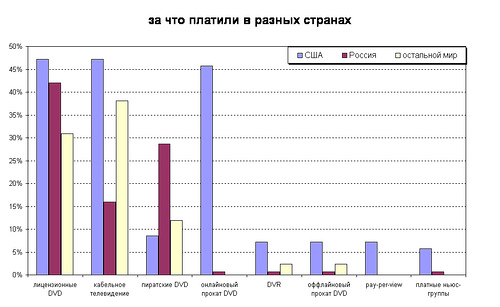 Chart 8
Chart 8
FROM WHERE
The countries that responded distributed as follows:
 Chart 9
Chart 9
WHERE TO TAKE AND HOW MUCH MUSIC SHIPS
The decomposition described in Chart 3 about downloading music by geography:
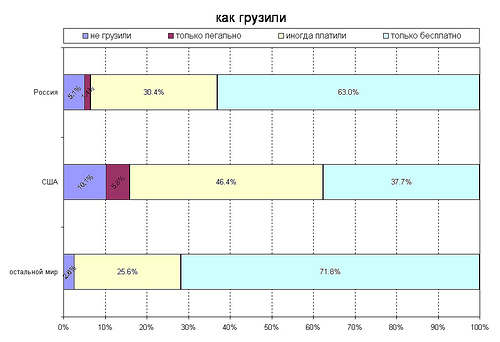 Chart 10
Chart 10
Same with the SF Bay Area:
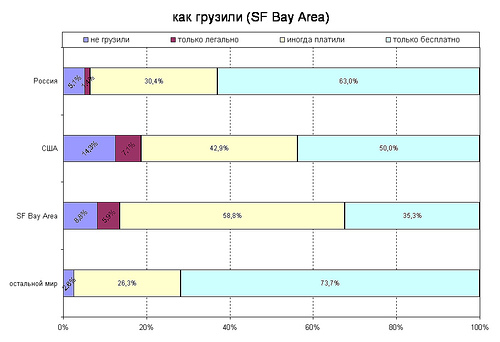 Chart 11
Chart 11
In the San Francisco Bay Area they pay for music one and a half times more often than in the rest of America, and twice as often as Russia.
According to free downloads, the “rest of the world” has overtaken both Russia and America.
* * * *
In 70% of respondents the most music appeared through a free download:
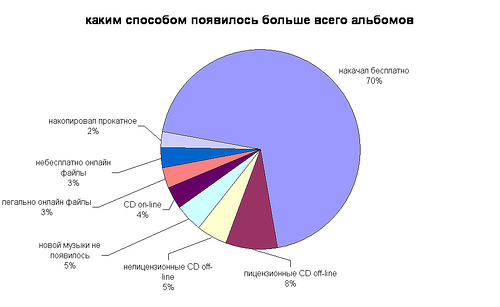 Chart 12
Chart 12
As already noted in Chart 5 , where the number of those who pumped was counted, for the most part, people don’t download files all day, even when they don’t pay for it at all. The need for new music in most people is very modest, regardless of its value.
A little more about these calculations:
- almost 30% load very little - they have no more than three new albums in the last three months;
- 14% generally listened to what they had before, or bought music off-line
- up to a dozen albums in three months (ie, 1 ... 3 albums per month) appeared by any means (including downloading and purchasing offline) in the other 23% of respondents
- Some notable amounts were loaded by 33% (22% reported the appearance of more than a dozen albums in three months, and only 11% - about many dozens).
In absolute terms:
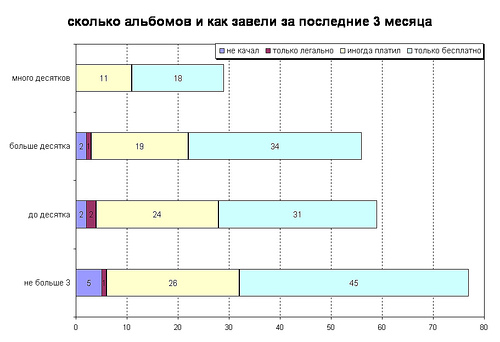 Chart 13
Chart 13
Normalized to 100% in each group:
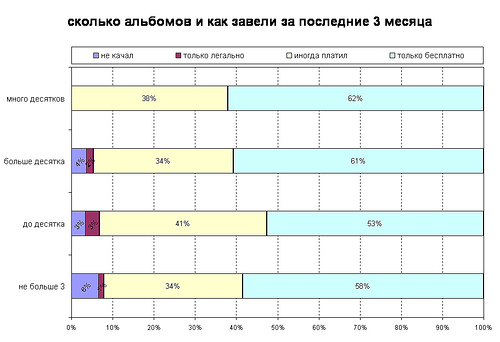 Chart 14
Chart 14
HOW TO RELATE TO MUSIC
Speaking about self-perception in connection with their music collections, 14% called themselves connoisseurs and collectors of rare music; 35% - just owners of large collections (not the fact that they are constantly listening to everything collected); half of the respondents do not perceive music at all as something affecting their self-identification.
WHAT ARE LISTEN TO MUSIC
Half of the people listening to music on the computer.
For almost the third part (29%) of the survey participants, the main sound-reproducing device is an mp3 player.
 Chart 15
Chart 15
The distribution of audio players around the world has shown that flash-mp3 players are the most popular type of players - every fifth respondent in the world uses it.
The prevalence of players with dozens of gigabytes of hard drives, allowing them to carry most of the actively listened collection with them, is 4 times higher in America than in Russia and the rest of the world.
The most popular sound reproducing devices outside the United States are a computer and a flash-mp3 player.
CD / mp3 players (playing audio or mp3 CDs) are used as the main source of sound in the USA 5 times less than in Russia and the world.
High-resolution audio players (SACD or DVD-Audio) in America listen to more than 5 times more than in the world outside of Russia, and Russian survey participants did not specify them as the main source of sound.
There were no satellite radio users as the main source of sound among the survey participants.
WHERE ARE SHIPPING
The most popular download method turned out to be file sharing (where you can click on the link in the browser) - 65% of the downloads used this method. The following most popular methods require installation on computers for download: BitTorrent (43%) on the second; eMule (aka "donkey") - in third place (39%).
11% of respondents sometimes legally bought content (from sites like iTunes, eMusic, napster, and other legal sources).
Not free sources used 18%.
One person could use more than one way to download.
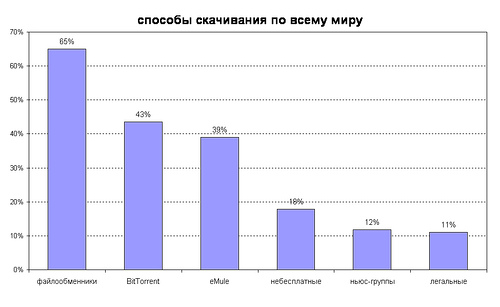 Chart 16
Chart 16
The distribution of download methods by geography shows that in the USA and Russia non-free sources were used by 19% of respondents in each country and 12% in the rest of the world.
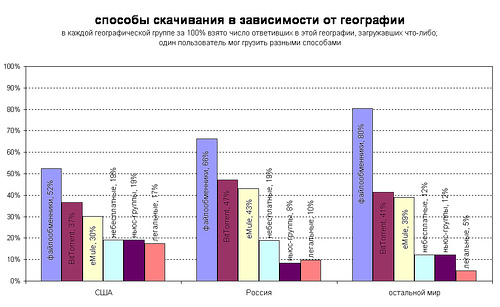 Chart 17
Chart 17
The following diagram shows how different download methods were combined for individual respondents:
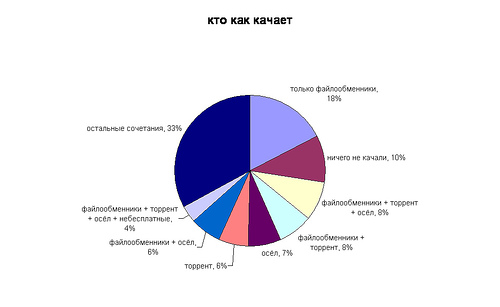 Chart 18
Chart 18
DOWNLOAD VIDEOS AND TRIPS IN CINEMA
Video downloaded two thirds of respondents (66%) - slightly less than music (87%).
The distribution of the world presented in Chart 6 :
 Chart 19
Chart 19
Owners of very large cinema collections (many hundreds / thousands of films) are few, and seem to be more passionate about picking up a movie than watching it. :)
Those whose collections include dozens / hundreds of films (of these 31%), on average, go to the movies more often:
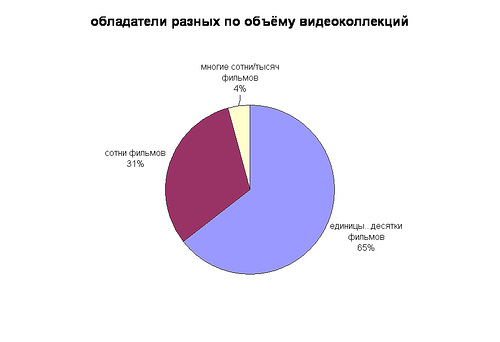 Chart 20
Chart 20
 Chart 21
Chart 21
 Chart 22
Chart 22
If it were necessary to draw any conclusions from the situation described, they could be, for example, such:
- The end of the era of music CDs and DVDs is not far off. The dying in America of music retailers is happening before our eyes. With the movie, it may slow down with the arrival of cheap BlueRay and HD-DVD players, but so far there is no feeling that this can happen earlier than in a year. Mining music and movies via the Internet has ceased to be a lot of computer freaks.
- Shrieks holders about the damage from piracy - no more than a pose. Those 9% who pump a lot and for free - most likely, insolvent demand. The rest is not much, regardless of the price. And when the distribution of content is conveniently organized, a third of the people are not against paying reasonable money now. Apparently, depicting the fight against piracy is still more effective than adjusting to new realities.
(this report was first published in my ZhZhurnale )
HIGHLIGHTS
=== Of every 10 LJ-ists, one shook a lot, six - only for free, three sometimes paid.
')
=== Only 2% of respondents legally downloaded music ...
PRO POLL
The survey began on April 7, 2007. In three weeks, 262 Russian-speaking LJ users took part in it.
57% of them live in Russia, 27% in the USA, 16% in the rest of the world.
I selected the American survey participants from the San Francisco Bay Area into a separate group because of the higher concentration of computer-literate people in these parts. Residents of the Bay Area accounted for 14% of the total number of respondents, the rest of America - 13%.
About download terminology:
- free of charge - this is from a donkey, news groups, a torrent, a district network, as a souvenir on a self-made disc from a friend, copied from a library, etc., where you are not charged anything for accessing these files;
- not for free - this is for money, but smaller than they usually want in official US stores like iTunes, that is, for example, on allofmp3.com, delit.net, mp3spy.ru, getmusic.ru, yanga.ru, etc. p. - everything that may be legal in Russia, but definitely angers right holders in America;
- legally - this is when a song is for 99 or more cents, an episode of a TV show for two green rubles, and a movie for 10 ... 15, OR music and movies from hire or library (not in copies), OR recorded on DVR, when you pay for this service to the cable provider, OR purchased at a regular store, OR at ibey, but in a real box / package, etc.
MUSIC
The survey once again confirmed that the world is changing.
Vinyl records have been replaced by CDs once. Now they are being supplanted by mp3 files, which often get from the Internet to computers and then to players, bypassing physical media. When asked what music is played most of the time, 57% of respondents said that they listen to music on a computer; 29% - in mp3-players (while 20% - in flash players, the rest - in players with built-in hard drive). Thus, for 87% of the audio files have already become what a couple of decades ago for the majority were vinyl records and compact tapes.
 Chart 1
Chart 1(all charts can be opened in a separate window - they will be easier to read)
* * * *
Those who spend a lot of time at the computer, spend money on the world in which they live - it happens that they pay for downloading music. Those who are at the computer no more than two hours a day, much more often get the music offline, and do not pay for downloading.
 Chart 2
Chart 2* * * *
Free downloading of music among Russian-speaking users of LiveJournal is massive - 92% of respondents know how and find where to download, not paying attention to legality.
58% of respondents shook only for free, 34% - sometimes paid. Only 2% of respondents rocked only legally. 6% did not download at all.
 Chart 3
Chart 3On closer inspection, 92% of those who swing for free look, however, less impressively: most of them are pumping quite a bit. Up to 3 albums appeared in 53% of respondents per month (by all means, download, copy, buy in offline stores, etc.).
 Chart 4
Chart 4Only 9% shakes a lot of music for free. “Many” - these are many dozens of new albums that have appeared over the past three months.
 Chart 5
Chart 5VIDEO
The video shakes a little less than the people than the music:
 Chart 6
Chart 6The following graph shows that the main sources of video for Americans are the purchase of licensed DVDs, cable television and online rental. And the Russians have no online DVD rental, but a high percentage of pirated discs. Thus - even with the opportunity to download for free, three or four out of every ten people pay for the video.
 Chart 8
Chart 8FROM WHERE
The countries that responded distributed as follows:
 Chart 9
Chart 9WHERE TO TAKE AND HOW MUCH MUSIC SHIPS
The decomposition described in Chart 3 about downloading music by geography:
 Chart 10
Chart 10Same with the SF Bay Area:
 Chart 11
Chart 11In the San Francisco Bay Area they pay for music one and a half times more often than in the rest of America, and twice as often as Russia.
According to free downloads, the “rest of the world” has overtaken both Russia and America.
* * * *
In 70% of respondents the most music appeared through a free download:
 Chart 12
Chart 12As already noted in Chart 5 , where the number of those who pumped was counted, for the most part, people don’t download files all day, even when they don’t pay for it at all. The need for new music in most people is very modest, regardless of its value.
A little more about these calculations:
- almost 30% load very little - they have no more than three new albums in the last three months;
- 14% generally listened to what they had before, or bought music off-line
- up to a dozen albums in three months (ie, 1 ... 3 albums per month) appeared by any means (including downloading and purchasing offline) in the other 23% of respondents
- Some notable amounts were loaded by 33% (22% reported the appearance of more than a dozen albums in three months, and only 11% - about many dozens).
In absolute terms:
 Chart 13
Chart 13Normalized to 100% in each group:
 Chart 14
Chart 14HOW TO RELATE TO MUSIC
Speaking about self-perception in connection with their music collections, 14% called themselves connoisseurs and collectors of rare music; 35% - just owners of large collections (not the fact that they are constantly listening to everything collected); half of the respondents do not perceive music at all as something affecting their self-identification.
WHAT ARE LISTEN TO MUSIC
Half of the people listening to music on the computer.
For almost the third part (29%) of the survey participants, the main sound-reproducing device is an mp3 player.
 Chart 15
Chart 15The distribution of audio players around the world has shown that flash-mp3 players are the most popular type of players - every fifth respondent in the world uses it.
The prevalence of players with dozens of gigabytes of hard drives, allowing them to carry most of the actively listened collection with them, is 4 times higher in America than in Russia and the rest of the world.
The most popular sound reproducing devices outside the United States are a computer and a flash-mp3 player.
CD / mp3 players (playing audio or mp3 CDs) are used as the main source of sound in the USA 5 times less than in Russia and the world.
High-resolution audio players (SACD or DVD-Audio) in America listen to more than 5 times more than in the world outside of Russia, and Russian survey participants did not specify them as the main source of sound.
There were no satellite radio users as the main source of sound among the survey participants.
WHERE ARE SHIPPING
The most popular download method turned out to be file sharing (where you can click on the link in the browser) - 65% of the downloads used this method. The following most popular methods require installation on computers for download: BitTorrent (43%) on the second; eMule (aka "donkey") - in third place (39%).
11% of respondents sometimes legally bought content (from sites like iTunes, eMusic, napster, and other legal sources).
Not free sources used 18%.
One person could use more than one way to download.
 Chart 16
Chart 16The distribution of download methods by geography shows that in the USA and Russia non-free sources were used by 19% of respondents in each country and 12% in the rest of the world.
 Chart 17
Chart 17The following diagram shows how different download methods were combined for individual respondents:
 Chart 18
Chart 18DOWNLOAD VIDEOS AND TRIPS IN CINEMA
Video downloaded two thirds of respondents (66%) - slightly less than music (87%).
The distribution of the world presented in Chart 6 :
 Chart 19
Chart 19Owners of very large cinema collections (many hundreds / thousands of films) are few, and seem to be more passionate about picking up a movie than watching it. :)
Those whose collections include dozens / hundreds of films (of these 31%), on average, go to the movies more often:
 Chart 20
Chart 20 Chart 21
Chart 21 Chart 22
Chart 22If it were necessary to draw any conclusions from the situation described, they could be, for example, such:
- The end of the era of music CDs and DVDs is not far off. The dying in America of music retailers is happening before our eyes. With the movie, it may slow down with the arrival of cheap BlueRay and HD-DVD players, but so far there is no feeling that this can happen earlier than in a year. Mining music and movies via the Internet has ceased to be a lot of computer freaks.
- Shrieks holders about the damage from piracy - no more than a pose. Those 9% who pump a lot and for free - most likely, insolvent demand. The rest is not much, regardless of the price. And when the distribution of content is conveniently organized, a third of the people are not against paying reasonable money now. Apparently, depicting the fight against piracy is still more effective than adjusting to new realities.
(this report was first published in my ZhZhurnale )
Source: https://habr.com/ru/post/7825/
All Articles